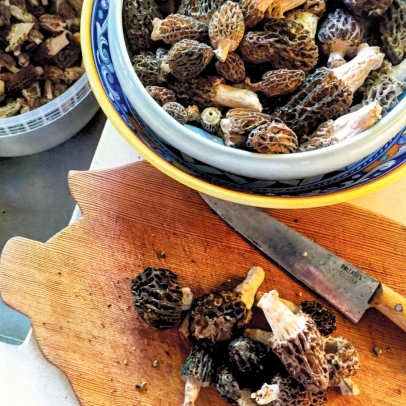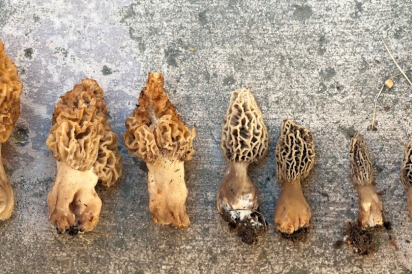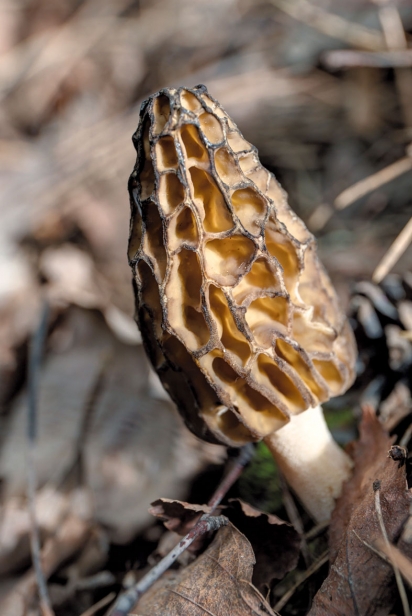The Spring Forager
Stalking the Wily Morel
Slowly comprehending my unbridled arrogance, hot tears stung my eyes. Hiking alone for hours in Northern California’s towering El Dorado National Forest, my gaze cast downward onto endless forest floor, I had lost my way. Rather than following a path or trail, or cleaving closely to the road, I had thoughtlessly meandered an enormous length of woods searching for one of springtime’s great culinary gifts: Morchella, the true morel mushroom.
Detaching from my mushroom eyes, I looked up and realized, with a gut-wrenching bolt of panic, I had absolutely no idea where I was. And, thanks to my helter-skelter approach to foraging, I had no idea from which direction I had come.
Complete damn amateur.
And the day had begun so well. I’d taken explicit driving directions from my foraging guide the day prior. We’d spent the day together hiking through several forests, 5,000 feet up the mountain, a 20-mile drive from its base. “Not another soul in sight,” I gratefully thought at the time. While we didn’t score the mother lode of fungi fantasies, my constant travel mate, a heavily patinaed carbon steel knife, cut through the stems of a half-dozen large morels, enough for a good supper.
Convinced that my highly focused solo return the following day would yield far better results, I was already anticipating packing the dehydrator; its reassuring whirring noise filling the kitchen with the funky, earthy aromas of mushroom, while Mason jars crammed with dried bounty filled the pantry.
Excitedly, I rose with the sun, greeting the day with a cup of tea, a stretch and a toke on the balcony of my lodging, overlooking newly green vineyards lining the bosomy hills of the town of Fair Play. I loaded a compass and altitude gauge onto my phone and filled a water bottle. Crackers, cheese and foraging knives went into mesh bags and a wicker foraging basket, both of which have ample openings for the morel’s thousands of microscopic spores to fall to the ground, reseeding the forest floor for future generations.
Driving the back roads of the conifer-covered central Sierra Nevada Mountains, I wound past the Bluebird Haven Iris Gardens, its hills ablaze in late-spring resplendence; past Glory Hole Road; past thousands of tiny, canary-yellow flowers blanketing an entire valley; past dozens of swallows playing in the early morning sunlight, their nests built under an ornately arched bridge reflected in a crystalline stream.
An hour later, my old German tank, its diesel-fired engine huffing and puffing, was slowly making its way up the dramatic Mormon Emigrant Trail. Tucked into the El Dorado National Forest, this 170-mile trail was cleared in 30 days by the Mormon Battalion, who had spent the winter of 1847 in Northern California at the command of their leader, Brigham Young. To return home to their church and families, they literally blazed their own trail, which was put to further use soon after by those seeking more earthly fortunes in California’s Gold Rush.
As soon as the altimeter read 4,000 feet, I slowed down to canvass for parcels of woods charred black from the California Department of Forestry and Fire Protection’s controlled burns—ideal habitat for the morel. “Stay in the burn” was the mantra repeated many times by yesterday’s foraging guide. While morels also grow outside of burn zones, fungi lovers have long believed those that sprout near a fire’s 1-yearold char are more intensely flavored. The theory is the combination of dying trees, here the conifer, and the extermination by burning of forest floor creates a veritable feast of decayed organic matter for the morel. Fire also eliminates the insects that feast upon them, allowing humans to gorge on relatively bug- and slug-free mushrooms.
Genetic analysis done by scientists at Oregon State University found that morels have grown for at least 129 million years, splitting off from other fungus at the dawn of the Cretaceous Period, when they were found underfoot of dinosaurs. And while there are more than 150 related species, the morel has remained mostly unchanged and true to its roots, aka its mycelium. Morels are saprotrophs, feeding off dead or dying trees and decomposing leaves, returning nutrients to the soil. More unusually, morels are also mycorrhizal fungi, which means that while they feed off the tree, they also provide it with water and nutrients. Nature’s interdependence, inclusive of the tiniest of organisms, is mind-blowing.
Many have tried, but there has been extremely limited success farming morels, so each spring the highly prized fungi’s nutty, dark flavors of earth and woodland compel ardent foragers around the world into their countryside. I was joining their legions, but maybe I had gone too far …
As trees begin to bud and snow melts away, unfiltered sunlight warms the ground and wildflowers bloom. It’s then the morel mushroom slowly emerges. The mushroom can take several weeks to achieve full size, living for two weeks before decomposing. Their season often continues for several months, the higher-elevation mushrooms the last to be seduced by spring’s warmth.
Like high stakes gamblers studying odds and players, commercial morel pickers familiarize themselves with last year’s forest fires and weather patterns. Fires in the summer followed by a heavy winter snowpack and a wet, early spring can bring yields of 75—100 pounds of morels per day. It takes 10 pounds of laboriously foraged fresh morels to yield one pound of premium dried morels—but commanding upwards of $300 per pound, it’s worthy prey.
Morels are quite distinct in the mushroom world, one of the many reasons I wandered the forest unguided and alone in search of them. I couldn’t possibly mistake the morel’s easily recognizable honeycomb design for any other liver-melting species of mushroom. Even the toxic “false morel’s” appearance is obviously different. One to six inches tall and sponge-like, the true morel can be found pushing up through the leaf litter. Like a tiny brown Christmas tree, the morel’s cap is cone shaped and roundish around the middle. Many times I’m giddy, convinced I’ve hit literal pay dirt, only to find small pinecones at my feet. The morel’s stem and cap are hollow, with the stem firmly attached to its base. It sounds clear and hollow when tapped, like a felt winter hat.
Hunting and fishing and foraging for food or artifacts provoke in me a greedy high akin to gambling; if I just get out there earlier and stay out a bit longer, try many different spots, stay in the game, get in the zone, I’m bound to get lucky. But I wasn’t feeling too lucky having gone astray for hours and hours in fathomless forest. Numerous large animal tracks in the mud had me looking over my shoulder in each clearing through which I passed.
As the sun moved westward, I envisioned sleeping in a pile of leaves, maybe even winning The Darwin Award, but, I prayed, not posthumously. I climbed a steep hill thick with pine, hoping to get a better look from above, my mind racing, ticking away with recriminations, self-loathing, panic. I tried to steady myself by reciting a list of morels’ habits and habitats:
Their preferred soils contain lime and calcium with a loamy mix of decaying organic matter, sand and clay.
Morels appear after the first rains of spring and after the nights warm to more than 40° Fahrenheit.
Morels can be found in old logging areas and forests with downed or burned trees and in areas where water once stood, near rivers and floodplains.
The name “morel” comes from the German word “morchel,” meaning mushroom.
As I neared the hilltop, my thoughts turned to calm gratitude for the forest’s fragrance, for the dappled sunlight, for a glimpse of a hawk and an owl, for the very large hunting knife in my basket. Descending the opposite side of the hill, I could only think of dinner.
After many hours and the third logging road hiked, I gratefully caught the glint of my wagon in the twilight of early evening. I sat on the ground next to the car, unlaced the hunting boots from my battered feet and wept, overjoyed at not spending the night alone in the deep woods.
Demoralized, but not demorelized: My mushroom basket was heavy with morels.
Back in the safety of the kitchen, a dozen black morel mushrooms were inspected for critters and rinsed free of the land. The chopped stalks of red Tropea onions, liberated days earlier from the garden, were sautéed with a generous corner from a block of salted Sonoma butter. The mushrooms were cut lengthwise and fanned over the wilted onions to cook through. A healthful splash of Bartoli Marsala sent up a steamy cloud aromatic of sunny, briny Sicily. Several eggs, fancy in their blue-green shells, were whipped with heavy cream, sea salt and a coarse grind of black and white pepper. Over a low flame, the eggs were married to the mushrooms, shirred with a whisk until just barely cooked, and finished with a spoon of fresh sheep-milk ricotta.
Pouring glasses from a hoarded bottle of Littorai Chardonnay, now fawn-colored in its advanced age, I recalled a warning read from one of the mycology books lining my desk: Eating morels while drinking alcohol may produce symptoms of great intoxication.







